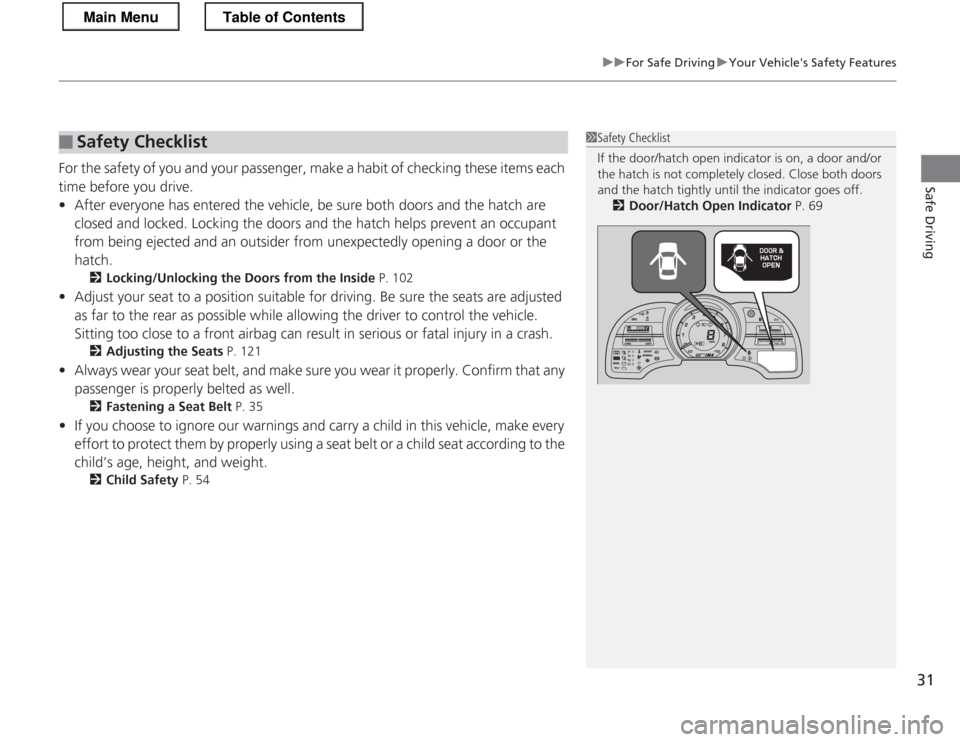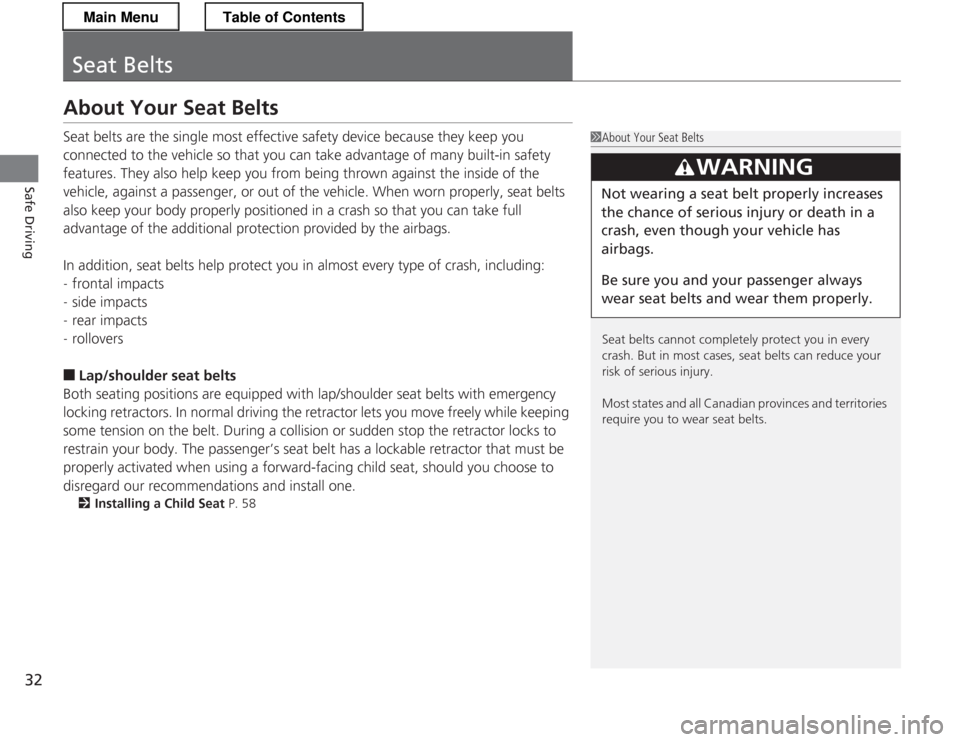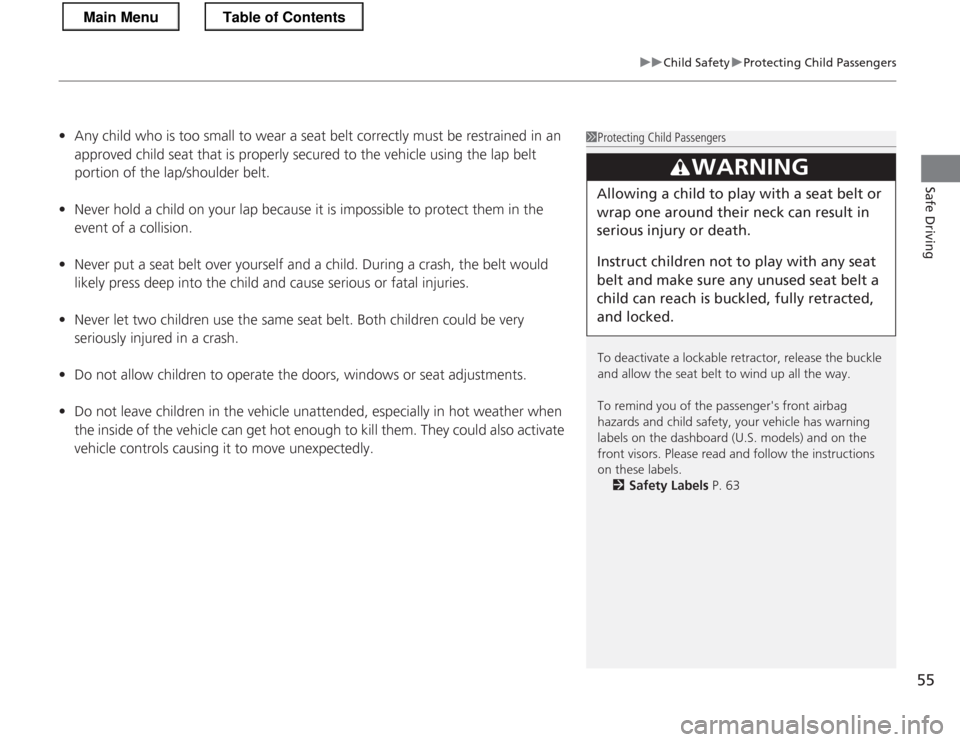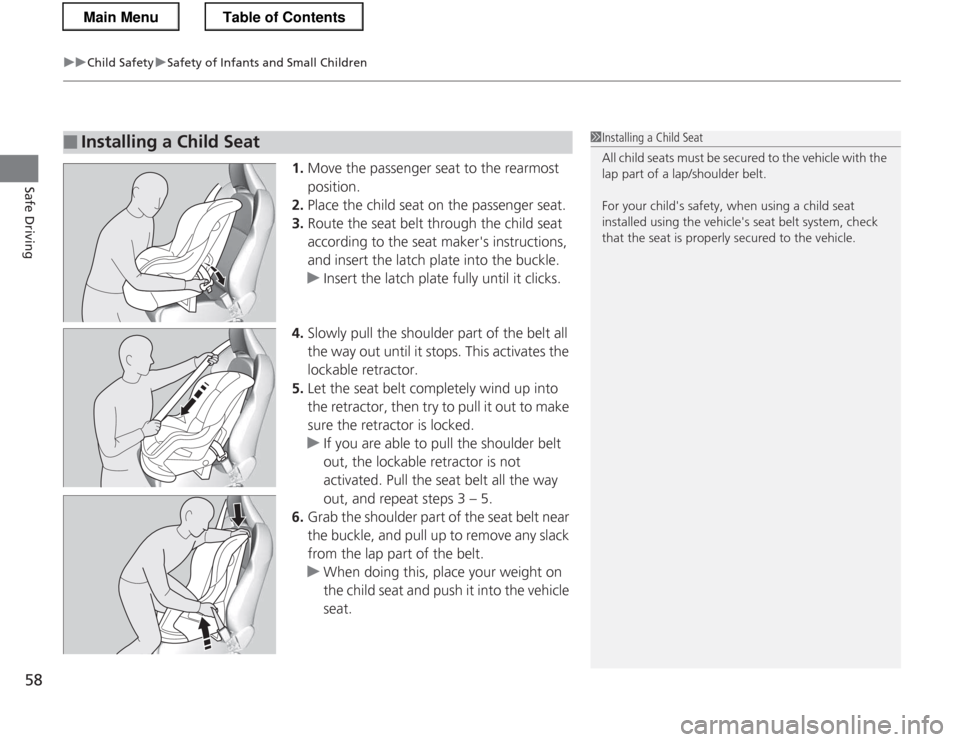Page 22 of 325
21
Quick Reference Guide
Maintenance (P221)
Under the Hood (P229)
● Check engine oil, engine coolant, and window washer fluid. Add when necessary.
● Check transmission fluid (CVT).
● Check brake fluid and clutch fluid.
● Check the 12 volt battery regularly.
a Pull the hood release handle under the corner of the
dashboard.
b Locate the hood latch lever, pull the lever up, and lift up
the hood.
c When finished, close the hood and make sure it is firmly
locked in place.
Lights (P242)
● Inspect all lights regularly.
Wiper Blades
(P250)
● Replace blades if they leave streaks
across the windshield.
Tires (P253)
● Inspect tires and wheels regularly.
● Check tire pressures regularly.
● Install snow tires for winter driving.
Main Menu
Page 24 of 325
23
Quick Reference Guide
What to Do If
The ignition switch does
not turn from
(0 to (q.
Why?
● The steering wheel may be locked.
● Move the steering wheel left and right
while turning the ignition key.
The ignition switch does
not turn from
(q to (0 and
I cannot remove the key.
Why?
The shift lever should be moved to (P on
the automatic transmission (CVT) model.
Why does the brake pedal
pulsate slightly when
applying the brakes?This can occur when the ABS activates, and does not indicate a
problem. Apply firm, steady pressu re on the brake pedal. Never
pump the brake pedal.
Why do the doors lock
after I unlocked the doors using a remote
transmitter?If you do not open the doors within 30 seconds, the doors are
relocked automatically for security.
Main Menu
Page 31 of 325

30
uuFor Safe DrivinguYour Vehicle's Safety Features
Safe Driving
Your Vehicle's Safety Features
The following checklist will help you take an active role in protecting yourself and your passenger.
1Your Vehicle's Safety Features
Your vehicle is equipped with many features that
work together to help protect you and your
passenger during a crash.
Some features do not require any action on your part.
These include a strong steel framework that forms a
safety cage around the passenger compartment,
front and rear crush zones, a collapsible steering
column, and tensioners that tighten the seat belts in
a sufficient crash.
However, you and your passenger cannot take full
advantage of these features unless you remain seated
in the correct position and always wear your seat
belts. In fact, some safety features can contribute to
injuries if they are not used properly.
6
7
89
10
11
12
7
8
9
10
6
7
8
9
10
12
Safety Cage
Crush Zones
Seats and Seat-Backs Head Restraints
Collapsible Steering Column Seat Belts
Front Airbags
Side Curtain Airbags Door Locks
Occupant Position Detection
System (OPDS) Sensor
Side Airbags
11Automatic Seat Belt Tensioners
Main MenuTable of Contents
Page 32 of 325

31
uuFor Safe DrivinguYour Vehicle's Safety Features
Safe Driving
For the safety of you and your passenger, make a habit of checking these items each
time before you drive.•After everyone has entered the vehicle, be sure both doors and the hatch are
closed and locked. Locking the doors and the hatch helps prevent an occupant
from being ejected and an outsider from unexpectedly opening a door or the
hatch. 2 Locking/Unlocking the Doors from the Inside P. 102
• Adjust your seat to a position suitable for driving. Be sure the seats are adjusted
as far to the rear as possible while allowing the driver to control the vehicle.
Sitting too close to a front airbag can result in serious or fatal injury in a crash.
2 Adjusting the Seats P. 121
• Always wear your seat belt, and make sure you wear it properly. Confirm that any
passenger is properly belted as well.
2 Fastening a Seat Belt P. 35
• If you choose to ignore our warnings and carry a child in this vehicle, make every
effort to protect them by properly using a seat belt or a child seat according to the
child’s age, height, and weight.
2 Child Safety P. 54
■Safety Checklist1Safety Checklist
If the door/hatch open indicator is on, a door and/or
the hatch is not completely closed. Close both doors
and the hatch tightly until the indicator goes off.
2 Door/Hatch Open Indicator P. 69
READY
Main MenuTable of Contents
Page 33 of 325

32
Safe Driving
Seat Belts
About Your Seat Belts
Seat belts are the single most effective safety device because they keep you
connected to the vehicle so that you can take advantage of many built-in safety
features. They also help keep you from being thrown against the inside of the vehicle, against a passenger, or out of the vehicle. When worn properly, seat belts
also keep your body properly positioned in a crash so that you can take full
advantage of the additional protection provided by the airbags.
In addition, seat belts help protect you in almost every type of crash, including: - frontal impacts
- side impacts
- rear impacts
- rollovers
■ Lap/shoulder seat belts
Both seating positions are equipped with lap/shoulder seat belts with emergency
locking retractors. In normal driving the retractor lets you move freely while keeping
some tension on the belt. During a collision or sudden stop the retractor locks to
restrain your body. The passenger’s seat belt has a lockable retractor that must be
properly activated when using a forward-facing child seat, should you choose to
disregard our recommendations and install one. 2 Installing a Child Seat P. 58
1About Your Seat Belts
Seat belts cannot completely protect you in every
crash. But in most cases, seat belts can reduce your risk of serious injury.
Most states and all Canadian provinces and territories
require you to wear seat belts.
3WARNING
Not wearing a seat belt properly increases
the chance of serious injury or death in a
crash, even though your vehicle has
airbags.
Be sure you and your passenger always
wear seat belts and wear them properly.
Main MenuTable of Contents
Page 34 of 325

Continued33
uuSeat BeltsuAbout Your Seat Belts
Safe Driving
■Proper use of seat belts
Follow these guidelines for proper use: • All occupants should sit upright, well back in the seat, and remain in that position
for the duration of the trip. Slouching and leaning reduces the effectiveness of
the belt and can increase the chance of serious injury in a crash.
• Never place the shoulder part of a lap/sh oulder seat belt under your arm or
behind your back. This could ca use very serious injuries in a crash.
• Two people should never use the same seat belt. If they do, they could be very
seriously injured in a crash.
• Do not put any accessories on the seat belts. Devices intended to improve comfort
or reposition the shoulder part of a seat belt can reduce the protective capability
and increase the chance of serious injury in a crash.
Your vehicle monitors seat belt use. If the
ignition switch is turned to ON
(w before the
driver's seat belt is fastened, a beeper will
sound and the indicator will blink. If the driver
does not fasten the belt before the beeper
stops, the indicator will remain on.
The beeper will also periodically sound and
the indicator will blink while driving until the
driver's and passenger’s seat belts are
fastened.
■Seat Belt Reminder
1About Your Seat Belts
If your passenger moves around and extends the seat
belt, the lockable retractor may activate. If this
happens, release the retr actor by unfastening the
seat belt and allow the belt to retract completely.
Then refasten the belt.
1Seat Belt Reminder
The indicator will also come on if a passenger does
not fasten their seat belt within 6 seconds after the
ignition switch is turned to ON
(w .
When no one is sitting in the passenger's seat, or a
child or small adult is riding there, the indicator will
not come on.
This is because the weight sensors in the seat cannot
detect their presence.
READY
Main MenuTable of Contents
Page 56 of 325

55
uuChild SafetyuProtecting Child Passengers
Safe Driving
•Any child who is too small to wear a seat belt correctly must be restrained in an
approved child seat that is properly secured to the vehicle using the lap belt
portion of the lap/shoulder belt.
• Never hold a child on your lap because it is impossible to protect them in the
event of a collision.
• Never put a seat belt over yourself and a child. During a crash, the belt would
likely press deep into the child and cause serious or fatal injuries.
• Never let two children use the same seat belt. Both children could be very
seriously injured in a crash.
• Do not allow children to operate the doors, windows or seat adjustments.
• Do not leave children in the vehic le unattended, especially in hot weather when
the inside of the vehicle can get hot enou gh to kill them. They could also activate
vehicle controls causing it to move unexpectedly.1Protecting Child Passengers
To deactivate a lockable retractor, release the buckle
and allow the seat belt to wind up all the way.
To remind you of the passenger's front airbag
hazards and child safety, your vehicle has warning
labels on the dashboard (U.S. models) and on the
front visors. Please read and follow the instructions
on these labels. 2 Safety Labels P. 63
3WARNING
Allowing a child to play with a seat belt or
wrap one around their neck can result in
serious injury or death.
Instruct children not to play with any seat
belt and make sure any unused seat belt a
child can reach is bu ckled, fully retracted,
and locked.
Main MenuTable of Contents
Page 59 of 325

uuChild SafetyuSafety of Infants and Small Children
58
Safe Driving
1. Move the passenger seat to the rearmost position.
2. Place the child seat on the passenger seat.
3. Route the seat belt through the child seat according to the seat maker's instructions,
and insert the latch plate into the buckle.
uInsert the latch plate fully until it clicks.
4. Slowly pull the shoulder part of the belt all
the way out until it stops. This activates the lockable retractor.
5. Let the seat belt completely wind up into
the retractor, then try to pull it out to make
sure the retractor is locked.
uIf you are able to pull the shoulder belt
out, the lockable retractor is not
activated. Pull the seat belt all the way
out, and repeat steps 3 – 5.
6. Grab the shoulder part of the seat belt near
the buckle, and pull up to remove any slack
from the lap part of the belt.
uWhen doing this, place your weight on
the child seat and push it into the vehicle seat.
■Installing a Child Seat1Installing a Child Seat
All child seats must be secured to the vehicle with the
lap part of a lap/shoulder belt.
For your child's safety, when using a child seat
installed using the vehicle's seat belt system, check
that the seat is properly secured to the vehicle.
Main MenuTable of Contents